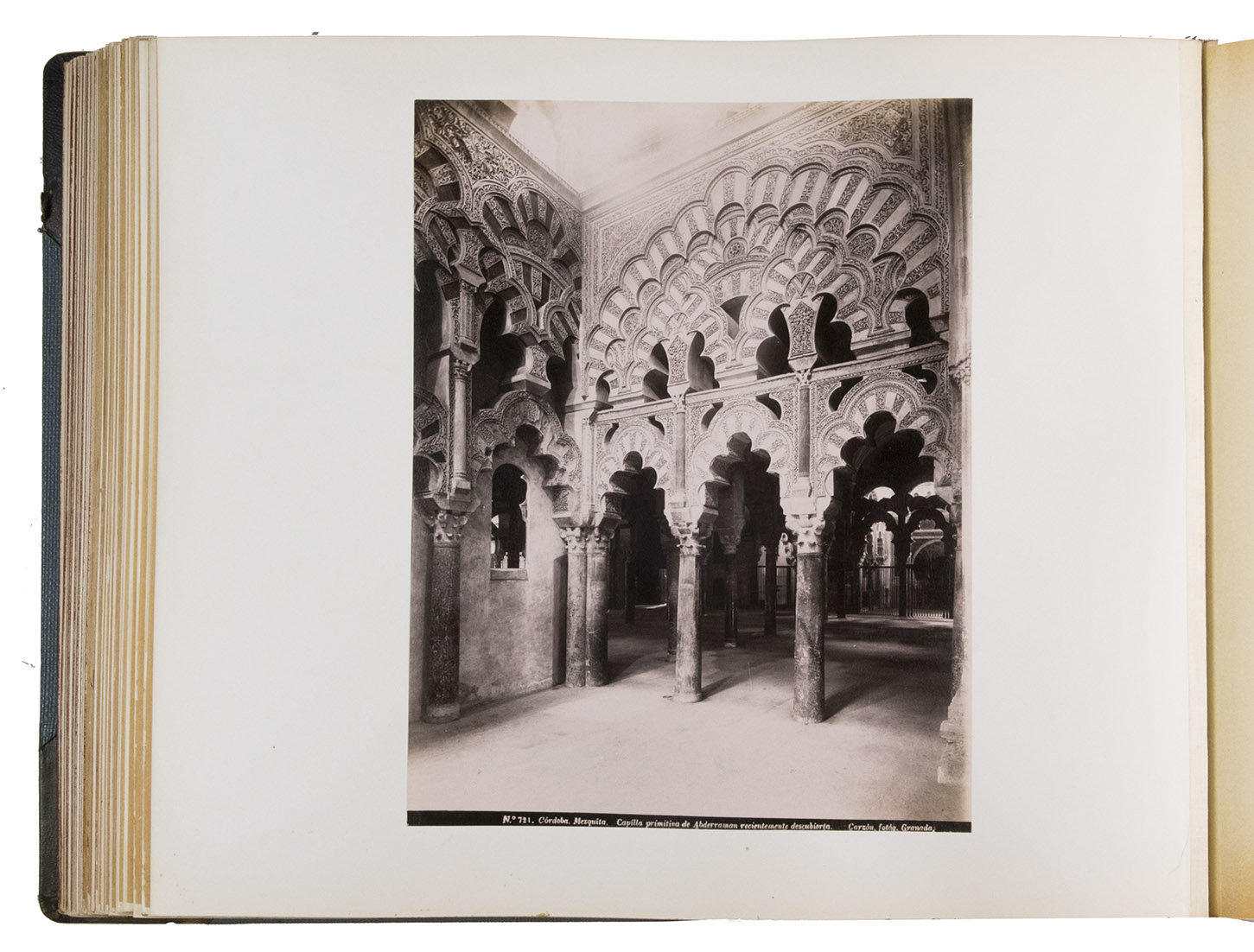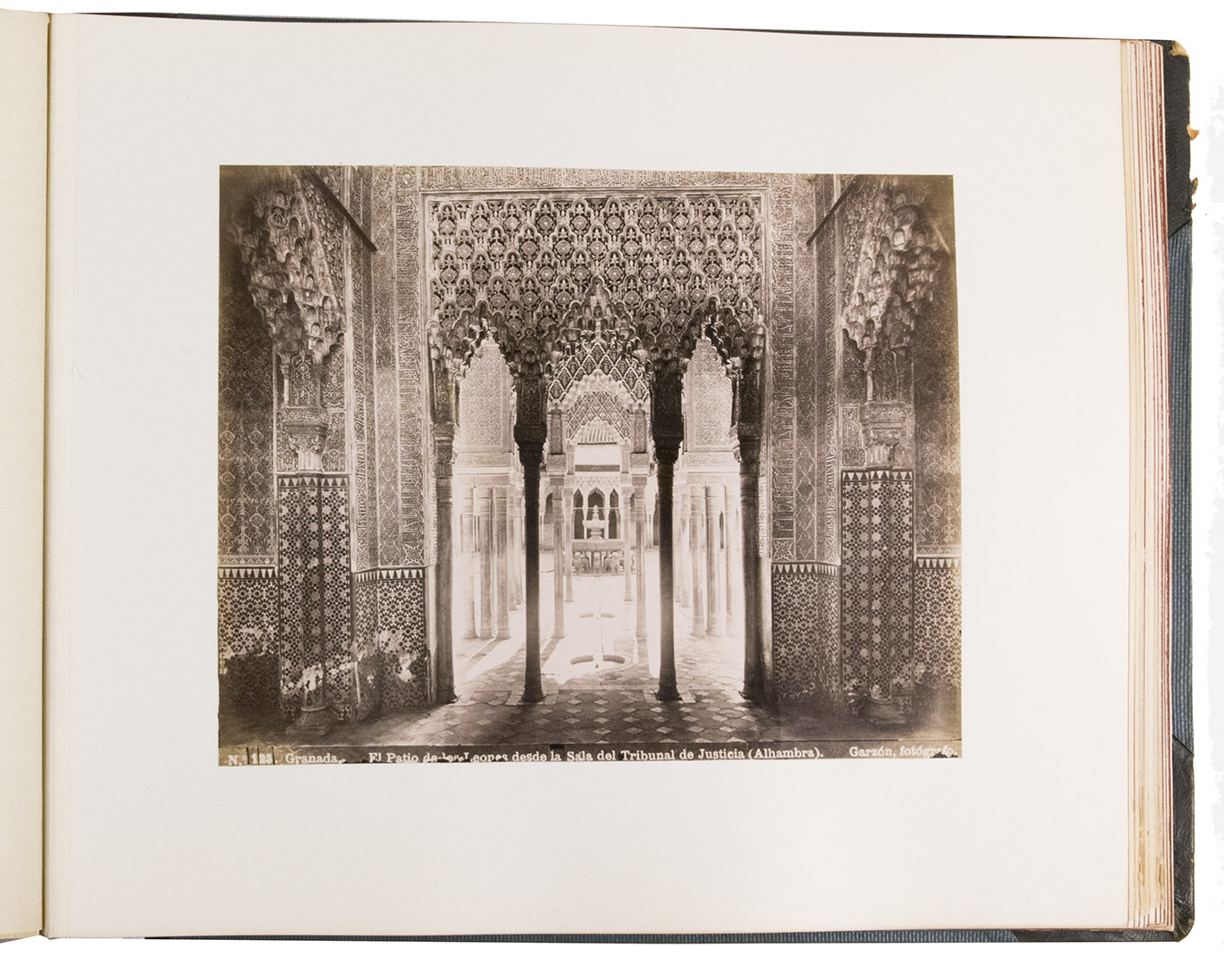GARZÓN RODRÍGUEZ, Rafael.
[Photography - Spain]. Toledo, Córdoba, Granada.
1890. Large oblong album (32 x 40 cm). 89 original photographs, mostly 20 x 26 cm. Half blind-tooled greenish brown calf and grey/green net grained cloth over boards, with the title in gold on the front board, red edges and decorated endpapers. [52] ll. interleaved with tissue paper.
€ 28,000
In 711, a Muslim army led by Tariq ibn Ziyad conquered most of the Iberian Peninsula, which was then part of the Visigothic Kingdom. This region became known as Al-Andalus, with Cordoba serving as its capital. In 756, Abd ar-Rahman I established the Emirate of Cordoba as an independent state. The present photo album covers in many photographs the magnificent architecture and features of the Great Mosque of Cordoba, which is considered one of the most significant architectural monuments of the western Islamic world. Built in 785, the mosque's most notable feature was its enormous hypostyle hall, comprised of rows of columns connected by double tiers of arches. The lower tier included horseshoe arches and was constructed with alternating red brick and light-colored stone. Abd ar-Rahman II expanded the mosque's dimensions in 836 while preserving its original design. His successors Muhammad, Al-Mundhir, and Abdallah also added new features to the mosque. One of the mosque's western gates, Bab al-Wuzara' (now known as Puerta de San Esteban), is a famous prototype of later Moorish architectural forms and motifs, featuring horseshoe arches with alternating coloured and decorated voussoirs set within a decorative rectangular frame called an alfiz.
At the centre of Garzóns photographic work on Córdoba was the Palace of the Lions, also known as the Court of the Lions (Patio de los Leones; Èåæ ÇáÓÈÇÚ). Situated in the center of the Alhambra with its ancient citadel consisting of a complex of forts, palaces, and gardens, this is one of the most buildings of the period of Muslim rule. The palace was commissioned by the Nasrid sultan Muhammed V of the Emirate of Granada during the second phase of his reign, between 1362 and 1391 AD. The general layout of the Palace of the Lions courtyard comprises an elongated rectangle with two halls facing each other at opposite ends, which is a common feature in numerous earlier palaces throughout Al-Andalus, including other Nasrid palaces located within the Alhambra (such as Comares Palace). Similar designs can even be traced back to the 10th century at Madinat al-Zahra, located near Cordoba. What sets the Palace of the Lions apart is the addition of two more halls, which face each other across the courtyard's shorter axis. This innovation is accompanied by an extension of the columned portico to encompass all four sides of the courtyard. The four converging water channels within the courtyard's floor are generally believed to be a symbolic representation of Paradise, which both Muslim and Christian traditions describe as having four rivers. This arrangement may have drawn inspiration from the Persian chahar bagh tradition, which involves a garden divided into four symmetrical parts along its central axis. The Palace of the Lions combines this with the classical peristyle tradition, which features a portico or arcade surrounding a courtyard. Other monuments in Al-Andalus and North Africa, where they are commonly referred to as a riad (or riyad), also feature gardens with a chahar bagh-type quadripartite division.
Rafael Garzón (1863-1923) was born in Granada became known as one of Spains foremost photographers of the early twentieth century. He owned studios situated inside the Alhambra of Granada, and in Seville. His photographic work mainly focused on capturing the landscapes and monuments of Andalucía, particularly his photographic portraits, which gained him recognition. His studio inside The Alhambra became particularly famous. Upon his arrival in Seville in 1901, he established a studio with an elaborate Arabic theme to enhance his photographs. He photographed the aristocrats of Seville, as well as the earliest tourists of the 19th century who visited Andalucía. The spread of his photographs contributed greatly to the rising touristic interest in Spain. Garzón's photography encompassed two distinct styles. His monumental photography of prominent Spanish structures such as the Alhambra, the Mosque-Cathedral of Córdoba, and the Cathedral and Reales Alcázares of Seville. The other style was a popular type of photography, designed to cater to the preconceived notions of foreign visitors seeking classic gypsy portraits from Sacromonte or the Carmenes from Córdoba or Seville. His photographic work was both of high quality and commercially attractive, and Garzón distributed them in various formats, including postcards, collector's items, and travel books.
The binding shows very slight signs of wear, mainly around the foot of the spine, the interleaved tissue paper is slightly browned, the upper-outer corner of the leaves is occasionally slightly dustsoiled.
Related Subjects:










